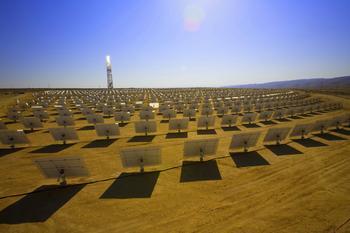
On March 17, the largest solar power project in the Middle East, the “Solar One” power station, was built in the desert area of the United Arab Emirates and successfully connected to the grid. Located in the desert area on the outskirts of Zayed, about 150 kilometers southwest of Abu Dhabi, the capital of the United Arab Emirates, the “Sun One” power station is considered to be the largest and most technologically advanced centralized solar power project in the Middle East, covering an area of 2.5 square meters. Km, which is equivalent to 300 football fields and has a power generation capacity of 100 MW, generates electricity for 20,000 UAE households.
The largest solar power project in the Middle East, the “Solar One” power station, was completed in the desert area of the United Arab Emirates on the 17th and was successfully connected to the grid for power generation.
Located in the desert area on the outskirts of Zayed, about 150 kilometers southwest of Abu Dhabi, the capital of the United Arab Emirates, the “Sun One” power station is considered to be the largest and most technologically advanced centralized solar power project in the Middle East, covering an area of 2.5 square meters. Km, which is equivalent to 300 football fields and has a power generation capacity of 100 MW, generates electricity for 20,000 UAE households.
UAE President Sheikh Khalifa Bin Zayed Al Nahyan, Vice President and Prime Minister, Sheikh Mohammed Bin Rashid Al Maktoum of Dubai, Crown Prince Abu Dhabi Sheikh Mohammed Ben Zayed Al Nahyan attended the opening ceremony of the day.
The President of the United Arab Emirates said at the ceremony that the completion of the power station shows that the UAE attaches great importance to fulfilling its commitment to expand investment and construction in the field of renewable energy. He emphasized that the "Solar One" power station is a solid step forward for the UAE to establish a diversified economy to ensure the long-term security of energy.
In an interview with Xinhua, the Director-General of the International Renewable Energy Agency, Amin Adnan, said that the opening of the “Solar One” power station is the starting point for planning the future blueprint for green energy in the Middle East, and the UAE’s example of renewable energy. And the commitment is of great significance to the Middle East region and the world as a whole.
According to reports, the “Sun One” power station, which has been incorporated into the UAE’s National Grid, has a total of 258,000 composite parabolic reflectors. These reflectors collect sunlight onto a special pipe, which is filled with a high thermal conductivity. The functional oil, hot oil, is sent to the steam generating device through the pipeline, and then steam is used to drive the turbine to generate electricity. The commissioning of the solar power station will not only ease the pressure on the UAE's electricity consumption, but also reduce carbon emissions by approximately 175,000 tons per year, equivalent to planting 1.5 million trees per year, or reducing the number of 15,000 cars on the road.
The “Solar One” power station was jointly completed by Masdar Energy of the United Arab Emirates, France’s Total Petroleum and Spain’s Arvengoa Solar. The UAE holds a 60% share, and France and Spain each hold 20%. The commissioning of the power station will also enable the Masdar Group in the United Arab Emirates to produce 68% of the total renewable energy produced in the Gulf region and 10% of the total installed global solar capacity.

 On March 17, the largest solar power project in the Middle East, the “Solar One” power station, was built in the desert area of the United Arab Emirates and successfully connected to the grid. Located in the desert area on the outskirts of Zayed, about 150 kilometers southwest of Abu Dhabi, the capital of the United Arab Emirates, the “Sun One” power station is considered to be the largest and most technologically advanced centralized solar power project in the Middle East, covering an area of 2.5 square meters. Km, which is equivalent to 300 football fields and has a power generation capacity of 100 MW, generates electricity for 20,000 UAE households.
On March 17, the largest solar power project in the Middle East, the “Solar One” power station, was built in the desert area of the United Arab Emirates and successfully connected to the grid. Located in the desert area on the outskirts of Zayed, about 150 kilometers southwest of Abu Dhabi, the capital of the United Arab Emirates, the “Sun One” power station is considered to be the largest and most technologically advanced centralized solar power project in the Middle East, covering an area of 2.5 square meters. Km, which is equivalent to 300 football fields and has a power generation capacity of 100 MW, generates electricity for 20,000 UAE households. 


